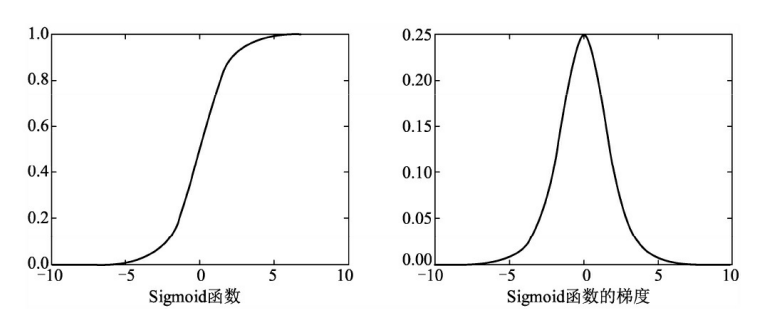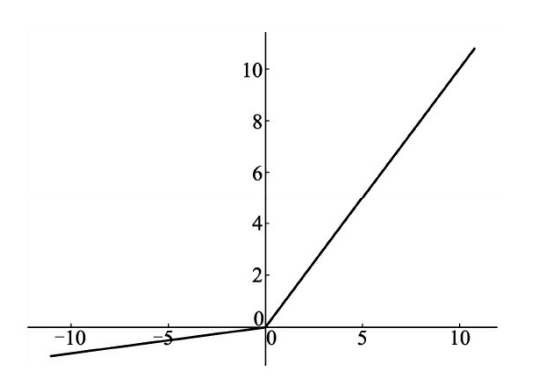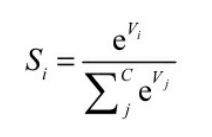神经网络如果仅仅是由线性的卷积运算堆叠组成,则其无法形成复杂的表达空间,也就很难提取出高语义的信息,因此还需要加入非线性的映射,又称为激活函数,可以逼近任意的非线性函数,以提升整个神经网络的表达能力。
在物体检测任务中,常用的激活函数有Sigmoid、 ReLU及Softmax函数。
目录
一、常见的激活函数
(1)Sigmoid函数
Sigmoid型函数又称为Logistic函数,模拟了生物的神经元特性,即当神经元获得的输入信号累计超过一定的阈值后,神经元被激活而处于兴奋状态,否则处于抑制状态。表达式如下所示:

Sigmoid函数曲线与梯度曲线如图1所示。可以看到,Sigmoid函数将特征压缩到了(0,1)区间,0端对应抑制状态,而1对应激活状态,中间部分梯度较大。

图1 Sigmoid函数及其梯度曲线
Sigmoid函数可以用来做二分类,但其计算量较大,并且容易出现梯度消失现象。从曲线图(图1)中可以看出,在Sigmoid函数两侧的 特征导数接近于0,这将导致在梯度反传时损失的误差难以传递到前面 的网络层(因为根据链式求导,梯度接近于0)。
(2)ReLU函数
为了缓解梯度消失现象,修正线性单元(Rectified Linear Unit, ReLU)被引入到神经网络中。由于其优越的性能与简单优雅的实现, ReLU已经成为目前卷积神经网络中最为常用的激活函数之一。ReLU函数的表达式如下所示。

ReLU函数及其梯度曲线如图2 所示。可以看出,在小于0的部分, 值与梯度皆为0,而在大于0的部分中导数保持为1,避免了Sigmoid函数中梯度接近于0导致的梯度消失问题。

图2 ReLU函数及其梯度曲线
ReLU函数计算简单,收敛快,并在众多卷积网络中验证了其有效性。
(3)Leaky ReLU函数
ReLU激活函数虽然高效,但是其将负区间所有的输入都强行置为 0,Leaky ReLU函数优化了这一点,在负区间内避免了直接置0,而是赋予很小的权重,其函数表达式如下所示。

以上公式中的 ai 代表权重,即小于0的值被缩小的比例。Leaky ReLU的函数曲线如图3 所示。

图3 Leaky ReLU函数曲线
虽然从理论上讲,Leaky ReLU函数的使用效果应该要比ReLU函数好,但是从大量实验结果来看并没有看出其效果比ReLU好。此外,对于ReLU函数的变种,除了Leaky ReLU函数之外,还有PReLU和RReLU 函数等,这里不做详细介绍。
(4)Softmax函数
在物体检测中,通常需要面对多物体分类问题,虽然可以使用 Sigmoid函数来构造多个二分类器,但比较麻烦,多物体类别较为常用的分类器是Softmax函数。
在具体的分类任务中,Softmax函数的输入往往是多个类别的得分,输出则是每一个类别对应的概率,所有类别的概率取值都在0~1之 间,且和为1。Softmax函数的表达式如下所示,其中,Vi表示第i 个类别的得分,C代表分类的类别总数,输出Si为第i个类别的概率。

二、Pytorch官方文件激活函数总结
(1)涉及的激活函数,以及公式
- nn.ReLU # f(x)= max(0, x)
- nn.ReLU6 # f(x) = min(max(0,x), 6)
- nn.ELU # f(x) = max(0,x) + min(0, alpha * (e^x - 1))
- nn.PReLU # f(x) = max(0,x) + a * min(0,x)
- nn.LeakyReLU # f(x) = max(0, x) + {negative_slope} * min(0, x)
- nn.Threshold # y=x,if x>=threshold y=value,if x<threshold
- nn.Hardtanh # f(x)=+1,if x>1; f(x)=−1,if x<−1; f(x)=x,otherwise
- nn.Sigmoid # f(x)=1/(1+e−x)
- nn.Tanh # f(x)=ex−e−xex+ex
- nn.LogSigmoid # f(x) = log( 1 / ( 1 + e^{-x}))
- nn.Softplus # f(x)=1beta∗log(1+e(beta∗xi))
- nn.Softshrink # f(x)=x−lambda,if x>lambda f(x)=x+lambda, if x<−lambda f(x)=0,otherwise
- nn.Softsign # f(x) = x / (1 + |x|)
- nn.Tanhshrink # f(x)=x−Tanh(x)
- nn.Softmin # fi(x)=e(−xi−shift)∑je(−xj−shift),shift=max(xi)
- nn.Softmax # fi(x)=e(xi−shift)∑je(xj−shift),shift=max(xi)
- nn.LogSoftmax # fi(x)=loge(xi)a,a=∑je(xj)
(2)代码示例(含注释)
import torch
import torch.nn as nn
from torch import autograd
# torch.nn.ReLU(inplace=False)
# 对输入运用修正线性单元函数${ReLU}(x)= max(0, x)$,
# 参数: inplace-选择是否进行覆盖运算
m = nn.ReLU()
input = autograd.Variable(torch.randn(2))
print(input)
print(m(input))
# torch.nn.ReLU6(inplace=False)
# 对输入的每一个元素运用函数${ReLU6}(x) = min(max(0,x), 6)$,
m = nn.ReLU6()
input = autograd.Variable(torch.randn(2))
print(input)
print(m(input))
# torch.nn.ELU(alpha=1.0, inplace=False)
# 对输入的每一个元素运用函数$f(x) = max(0,x) + min(0, alpha * (e^x - 1))$
m = nn.ELU()
input = autograd.Variable(torch.randn(2))
print(input)
print(m(input))
# torch.nn.PReLU(num_parameters=1, init=0.25)
# 对输入的每一个元素运用函数$PReLU(x) = max(0,x) + a * min(0,x)$,a 是一个可学习参数。
# 当没有声明时,nn.PReLU()在所有的输入中只有一个参数 a;
# 如果是 nn.PReLU(nChannels),a 将应用到每个输入。
# 注意:当为了表现更佳的模型而学习参数 a 时不要使用权重衰减(weight decay)
# 参数:
# num_parameters:需要学习的 a 的个数,默认等于 1
# init:a 的初始值,默认等于 0.25
m = nn.PReLU()
input = autograd.Variable(torch.randn(2))
print(input)
print(m(input))
# torch.nn.LeakyReLU(negative_slope=0.01, inplace=False)
# 对输入的每一个元素运用$f(x) = max(0, x) + {negative_slope} * min(0, x)$
# 参数:
# negative_slope:控制负斜率的角度,默认等于 0.01
# inplace-选择是否进行覆盖运算
m = nn.LeakyReLU(0.1)
input = autograd.Variable(torch.randn(2))
print(input)
print(m(input))
import torch
import torch.nn as nn
from torch import autograd
# torch.nn.Threshold(threshold, value, inplace=False)
# Threshold 定义:y=x,if x>=threshold y=value,if x<threshold
# 参数:
# threshold:阈值
# value:输入值小于阈值则会被 value 代替
# inplace:选择是否进行覆盖运算
m = nn.Threshold(0.1, 20)
input = autograd.Variable(torch.Tensor([0.26, 0]))
print(input)
print(m(input))
# torch.nn.Hardtanh(min_value=-1, max_value=1, inplace=False)
# 对每个元素,f(x)=+1,if x>1; f(x)=−1,if x<−1; f(x)=x,otherwise
# 线性区域的范围[-1,1]可以被调整
# 参数:
# min_value:线性区域范围最小值
# max_value:线性区域范围最大值
# inplace:选择是否进行覆盖运算
m = nn.Hardtanh()
input = autograd.Variable(torch.Tensor([0.2, -3, 5]))
print(input)
print(m(input))
# torch.nn.Sigmoid
# 对每个元素运用 Sigmoid 函数,Sigmoid 定义如下:f(x)=1/(1+e−x)
m = nn.Sigmoid()
input = autograd.Variable(torch.Tensor([0, 3, 10]))
print(input)
print(m(input))
# torch.nn.Tanh
# 对输入的每个元素,f(x)=ex−e−xex+ex
m = nn.Tanh()
input = autograd.Variable(torch.randn(2))
print(input)
print(m(input))
# torch.nn.LogSigmoid
# 对输入的每个元素,$LogSigmoid(x) = log( 1 / ( 1 + e^{-x}))$
m = nn.LogSigmoid()
input = autograd.Variable(torch.randn(2))
print(input)
print(m(input))
# torch.nn.Softplus(beta=1, threshold=20)
# 对每个元素运用 Softplus 函数,Softplus 定义如下:f(x)=1beta∗log(1+e(beta∗xi))
# Softplus 函数是 ReLU 函数的平滑逼近,Softplus 函数可以使得输出值限定为正数。
# 为了保证数值稳定性,线性函数的转换可以使输出大于某个值。
# 参数:
# beta:Softplus 函数的 beta 值
# threshold:阈值
m = nn.Softplus(beta=2, threshold=10)
m1 = nn.Softplus()
input = autograd.Variable(torch.randn(2))
print(input)
print(m(input))
print(m1(input))
# torch.nn.Softshrink(lambd=0.5)
# 对每个元素运用 Softshrink 函数,Softshrink 函数定义如下:
# f(x)=x−lambda,if x>lambda f(x)=x+lambda,if x<−lambda f(x)=0,otherwise
# 参数:
# lambd:Softshrink 函数的 lambda 值,默认为 0.5
m = nn.Softshrink()
input = autograd.Variable(torch.randn(2))
print(input)
print(m(input))
# torch.nn.Softsign
# $f(x) = x / (1 + |x|)$
m = nn.Softsign()
input = autograd.Variable(torch.Tensor([1, 2]))
print(input)
print(m(input))
# torch.nn.Softshrink(lambd=0.5)
# 对每个元素运用 Tanhshrink 函数,Tanhshrink 函数定义如下:
# Tanhshrink(x)=x−Tanh(x)
m = nn.Tanhshrink()
input = autograd.Variable(torch.randn(2))
m_tanh = nn.Tanh()
print(input)
print(m_tanh(input))
print(m(input))
# torch.nn.Softmin
# 对 n 维输入张量运用 Softmin 函数,将张量的每个元素缩放到(0,1)区间且和为 1。Softmin 函数定义如下:
# fi(x)=e(−xi−shift)∑je(−xj−shift),shift=max(xi)
# dim (int):计算 Softmin 的维度(因此沿 dim 的每个切片的总和为 1)。
m = nn.Softmin(dim=0)
input = autograd.Variable(torch.randn(2, 3))
print(input)
print(m(input))
# torch.nn.Softmax
# 对 n 维输入张量运用 Softmax 函数,将张量的每个元素缩放到(0,1)区间且和为 1。
# Softmax 函数定义如下:fi(x)=e(xi−shift)∑je(xj−shift),shift=max(xi)
# 返回结果是一个与输入维度相同的张量,每个元素的取值范围在(0,1)区间。
m = nn.Softmax(dim=0)
input = autograd.Variable(torch.randn(2, 3))
print(input)
print(m(input))
# torch.nn.LogSoftmax
# 对 n 维输入张量运用 LogSoftmax 函数,LogSoftmax 函数定义如下:
# fi(x)=loge(xi)a,a=∑je(xj)
m = nn.LogSoftmax(dim=0)
input = autograd.Variable(torch.randn(2, 3))
print(input)
print(m(input))
>>>本文参考:Pytoch官方文件 &&《深度学习之PyTorch物体检测实战》
>>>如有疑问,欢迎评论区一起探讨
























 835
835











 被折叠的 条评论
为什么被折叠?
被折叠的 条评论
为什么被折叠?










